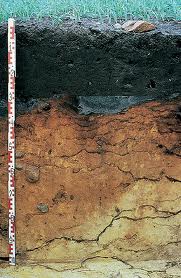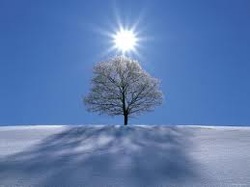Soil in Taiga

The typical taiga soil is called podzol or podsol. It has a dark upper horizon (A); this layer is dark because it's rich in humus formed from decomposition of the leaf litter.
Horizon A is followed by a characteristic lighter (whitish) eluvial horizon (E); the mineral components of this layer have drained toward the deeper, usually brownish B horizon.
The B horizon overlays the broken down rock (C horizon).
Mostly the podsol in the Taiga is very poor for agriculture. This is due to the excessively sandy texture which cannot retain water for plants to survive. However, some podsol is not completely sandy. Despite the lack of sand, they only provide shallow rooting zones and have terrible drainage due to soil cementation. This type of podsol drowns out plants and prevents them from thriving. In addition, the shedded evergreen leaves decompose in the soil and add to the acidity of the soil and thus, kill smaller plants attempting to grow. Despite the terrible soil, many plants continue to grow and trees especially are able to survive in this harsh soil.
Horizon A is followed by a characteristic lighter (whitish) eluvial horizon (E); the mineral components of this layer have drained toward the deeper, usually brownish B horizon.
The B horizon overlays the broken down rock (C horizon).
Mostly the podsol in the Taiga is very poor for agriculture. This is due to the excessively sandy texture which cannot retain water for plants to survive. However, some podsol is not completely sandy. Despite the lack of sand, they only provide shallow rooting zones and have terrible drainage due to soil cementation. This type of podsol drowns out plants and prevents them from thriving. In addition, the shedded evergreen leaves decompose in the soil and add to the acidity of the soil and thus, kill smaller plants attempting to grow. Despite the terrible soil, many plants continue to grow and trees especially are able to survive in this harsh soil.
Productivity of Taiga

Gross Productivity is the amount of energy that is stored by in organic matter in the biome. This differs from the net productivity which is the gross productivity minus the amount of energy stored which will be utilized for respiration. For our specific biome, the average gross productivity is around 2000 kcal/m^2/year.
Primary productivity is the productivity of the first trophic level. This includes the energy stored by all the plants in the ecosystem including the trees and shrubs. Secondary Productivity is the productivity of the second trophic level. These heterotrophs eat the first trophic level species and generally retain about 10% of the energy consumed.
Species in the Taiga
Here is a general list of the types of animals and plants that you will find in the taiga biome:
- Decomposes: Fungus and bacteria
- Producers: evergreen trees, grass, shrubs, lichen, moss
- Primary consumers: insects, porcupine, moose, deer, caribou, squirrels, elk, mice, birds
- Secondary consumers: fox, owls, bats, raccoons, minks, weasel
- Top consumers: wolf, bear, wolverine hawks, Siberian tiger
The first trophic level of the taiga consists of the producers listed above. The primary consumers are the second trophic level. The secondary consumers are the third trophic level and the top consumers listed above are the tertiary consumers. Because energy depletes as you go up trophic levels, forth trophic level animals are not commonly found.
Because of the Taiga's harsh climate and the negative effects of human interference the animals below are currently endangered:










